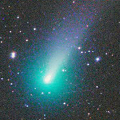
|
It brightened up to 5.1 mag in the morning sky (Dec. 12, Carlos Labordena). Then it brightened up to 3.2 mag in outburst on Dec. 15 (Dec. 15, Mike Olason). It turns to be observable in the evening low sky since mid December. It stays 4-5 mag in December. It stays observable until early January in the Northern Hemisphere, or until late January in the Southern Hemisphere. In the Southern Hemisphere, it becomes observable in the morning sky after late February.
Date(TT) R.A. (2000) Decl. Delta r Elong. m1 Best Time(A, h)
Dec. 11 16 18.59 7 7.5 0.242 0.792 32 4.4 5:27 (268, 11)
Dec. 18 19 39.40 -25 22.1 0.324 0.709 26 4.6 18:21 ( 55, 3)
|
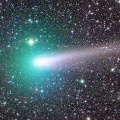
|
Now it is very bright as 8.9 mag (Dec. 4, Marco Goiato). It stays 9 mag until January, and it is observable in good condition. A very long dust trail is detected.
Date(TT) R.A. (2000) Decl. Delta r Elong. m1 Best Time(A, h)
Dec. 11 8 57.91 27 22.6 0.437 1.305 129 8.9 3:40 ( 0, 82)
Dec. 18 9 1.83 27 44.0 0.447 1.339 135 8.9 3:16 ( 0, 83)
|
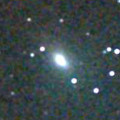
|
Now it is bright as 10.7 mag (Dec. 4, Marco Goiato). It stays bright as 9-10 mag until March. In the Southern Hemisphere, it is observable in excellent condition. It will be getting higher rapidly after this also in the Northren Hemisphere.
Date(TT) R.A. (2000) Decl. Delta r Elong. m1 Best Time(A, h)
Dec. 11 23 40.73 -32 9.9 1.175 1.448 83 9.9 18:21 ( 0, 23)
Dec. 18 23 52.22 -27 43.6 1.176 1.415 81 9.6 18:21 ( 4, 28)
|
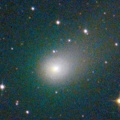
|
Now it is 9.5 mag (Dec. 14, Chris Wyatt). It stays bright as 10 mag until spring for a long time. It stays observable in good condition for a long time. It locates somewhat low in the Southern Hemisphere,
Date(TT) R.A. (2000) Decl. Delta r Elong. m1 Best Time(A, h)
Dec. 11 7 32.94 36 15.2 2.700 3.565 146 9.9 2:16 (180, 89)
Dec. 18 7 26.76 35 15.2 2.647 3.560 154 9.9 1:42 (180, 90)
|
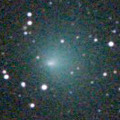
|
Now it is bright as 10.6 mag (Nov. 27, Marco Goiato). It is observable at 10 mag in good condition from October to December. In the Northern Hemisphere, it locates somewhat low at the high light.
Date(TT) R.A. (2000) Decl. Delta r Elong. m1 Best Time(A, h)
Dec. 11 23 0.14 -25 8.5 1.545 1.651 78 10.8 18:19 ( 10, 29)
Dec. 18 23 19.87 -23 18.4 1.636 1.694 76 11.2 18:21 ( 13, 31)
|
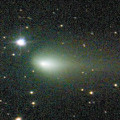
|
Now it is bright as 11.7 mag (Dec. 13, Osamu Miyazaki). It stays observable in good condition for a long time. But it will be fading gradually after this.
Date(TT) R.A. (2000) Decl. Delta r Elong. m1 Best Time(A, h)
Dec. 11 6 50.82 7 14.2 0.944 1.869 151 11.1 1:33 ( 0, 62)
Dec. 18 6 45.68 7 5.3 0.956 1.904 157 11.3 1:01 ( 0, 62)
|
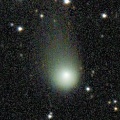
|
Now it is bright as 11.1 mag (Nov. 11, Osamu Miyazaki). It is expected to be observable at 5-6 mag for a long time from 2022 to 2023. In the Northern Hemisphere, it becomes extremely low temporarily in December, but it will be getting higher again after January. However, it is not observable at the high light from 2022 autumn to 2023 summer. In the Southern Hemisphere, it is not observable until February. But it will be observable in good condition at the high light.
Date(TT) R.A. (2000) Decl. Delta r Elong. m1 Best Time(A, h)
Dec. 11 17 40.81 15 11.0 5.308 4.582 38 11.2 18:19 (102, 9)
Dec. 18 17 46.32 14 28.5 5.257 4.520 37 11.2 18:21 (105, 4)
|
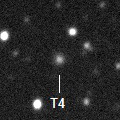
|
Now it is 13.4 mag (Dec. 14, Chris Wyatt). It is expected to brighten up to 11.5 mag in 2022. It stas observable in good condition for a long time.
Date(TT) R.A. (2000) Decl. Delta r Elong. m1 Best Time(A, h)
Dec. 11 11 48.88 -28 35.4 4.713 4.498 71 12.6 5:27 (345, 25)
Dec. 18 11 53.44 -28 56.5 4.602 4.479 76 12.5 5:31 (351, 25)
|
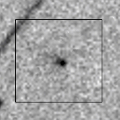
|
Now it is not observable. In the Southern Hemisphere, it will appear in the morning sky at 11 mag in late January, then it stays observable at 11 mag until June. In the Northern Hemisphere, it will appear in the morning sky in December, but it stays locating extremely low for a long time.
Date(TT) R.A. (2000) Decl. Delta r Elong. m1 Best Time(A, h)
Dec. 11 15 51.32 -17 3.5 2.725 1.828 19 13.0 5:27 (292, 1)
Dec. 18 16 10.66 -18 2.6 2.667 1.794 22 12.8 5:31 (294, 3)
|
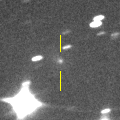
|
Now it is 14.7 mag (Nov. 24, Ken-ichi Kadota). Brightening rapidly. It is expected to be observable at 12-13 mag in good condition from December to February.
Date(TT) R.A. (2000) Decl. Delta r Elong. m1 Best Time(A, h)
Dec. 11 22 56.71 -8 53.2 0.731 1.154 83 13.1 18:19 ( 15, 45)
Dec. 18 23 17.12 -7 54.5 0.715 1.123 81 12.8 18:21 ( 18, 46)
|
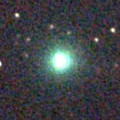
|
It brightened very rapidly, and brightened up to 8.9 mag (Sept. 11, Chris Wyatt). Now it is fading. But it is bright as 10.4 mag still now (Nov. 13, Chris Wyatt). In the Southern Hemisphere, it stays observable after this while the comet will be fading. But it stays locating low. It is not observable after this in the Northern Hemisphere.
Date(TT) R.A. (2000) Decl. Delta r Elong. m1 Best Time(A, h)
Dec. 11 14 53.47 -51 4.4 2.471 1.810 38 12.8 5:27 (326,-12)
Dec. 18 15 16.04 -51 59.0 2.527 1.883 39 13.2 5:31 (327,-11)
|
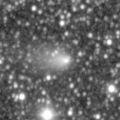
|
Major outburst occured on Oct. 17. Now it is very bright as 11.9 mag (Nov. 27, Toshihiko Ikemura, Hirohisa Sato). In the Southern Hemisphere, it becomes unobservable in late December. In the Northern Hemisphere, it stays observable until early February.
Date(TT) R.A. (2000) Decl. Delta r Elong. m1 Best Time(A, h)
Dec. 11 20 39.98 -16 59.8 2.275 1.792 49 12.9 18:19 ( 47, 23)
Dec. 18 20 58.92 -15 52.1 2.339 1.811 46 13.2 18:21 ( 50, 22)
|
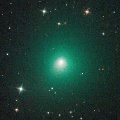
|
It brightened up to 9.5 mag in early summer (June 27, Marco Goiato). Now it is fading. It has already faded down to 12.7 mag (Nov. 22, Thomas Lehmann). Now it is not observable. In the Southern Hemisphere, it will appear in the morning sky at 15 mag in late February. In the Northern Hemisphere, it is not observable until June when the comet will fade down to 17 mag.
Date(TT) R.A. (2000) Decl. Delta r Elong. m1 Best Time(A, h)
Dec. 11 18 54.29 -33 0.9 3.580 2.717 24 13.3 18:19 ( 53, -5)
Dec. 18 19 9.61 -33 12.5 3.661 2.769 21 13.5 18:21 ( 55, -8)
|

|
Major outburst occured on Sept. 25, and it brightened up to 10.0 mag (Oct. 1, Toshihiko Ikemura, Hirohisa Sato). Now it is fading. But it is bright as 10.8 mag still now (Dec. 2, Toshihiko Ikemura, Hirohisa Sato).
Date(TT) R.A. (2000) Decl. Delta r Elong. m1 Best Time(A, h)
Dec. 11 4 31.83 31 43.5 4.973 5.938 167 13.3 23:10 ( 0, 87)
Dec. 18 4 28.17 31 30.5 4.998 5.940 161 13.3 22:39 ( 0, 87)
|
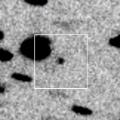
|
Now it is 15.5 mag (Nov. 14, Ken-ichi Kadota). It will brighten up to 12 mag from winter to spring. In the Northern Hemisphere, it is appearing in the morning sky. In the Southern Hemisphere, it is not observable until January.
Date(TT) R.A. (2000) Decl. Delta r Elong. m1 Best Time(A, h)
Dec. 11 14 39.73 -9 30.7 2.401 1.744 38 13.5 5:27 (297, 19)
Dec. 18 14 58.43 -11 12.0 2.334 1.715 40 13.3 5:31 (301, 20)
|

|
It brightened up to 12.3 mag from spring to summer (June 15, Marco Goiato). Now it is fading. It has already faded down to 14.1 mag (Nov. 23, Ken-ichi Kadota). In the Northern Hemisphere, it is appearing in the morning sky. It is not observable until January in the Southern Hemisphere.
Date(TT) R.A. (2000) Decl. Delta r Elong. m1 Best Time(A, h)
Dec. 11 14 24.68 1 33.4 4.603 4.004 47 14.0 5:27 (291, 29)
Dec. 18 14 26.49 2 21.8 4.535 4.038 54 14.0 5:31 (296, 35)
|
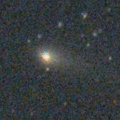
|
Now it is 13.1 mag (Nov. 27, Toshihiko Ikemura, Hirohisa Sato). It stays 13-14 mag unil December, and it is observable in excellent condition.
Date(TT) R.A. (2000) Decl. Delta r Elong. m1 Best Time(A, h)
Dec. 11 1 3.74 -0 44.5 1.044 1.714 115 14.4 19:44 ( 0, 54)
Dec. 18 1 14.54 0 23.9 1.107 1.727 111 14.5 19:27 ( 0, 56)
|

|
Now it is 15.1 mag (Dec. 14, Chris Wyatt). It is expected to brighten up to 13 mag in 2022. In the Southern Hemisphere, it stays observable in good condition for a long time. In the Northern Hemisphere, it becomes observable temporarily in the extremely low sky in December. But it becomes unobservable again soon.
Date(TT) R.A. (2000) Decl. Delta r Elong. m1 Best Time(A, h)
Dec. 11 12 49.30 -45 43.4 4.058 3.617 56 14.6 5:27 (339, 4)
Dec. 18 12 49.43 -47 59.2 3.942 3.584 61 14.5 5:31 (345, 4)
|
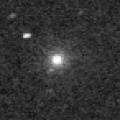
|
It was observed at 9-10 mag from late July to early August. Although it had been unobservable for a long time, it is appearing in the morning sky now.
Date(TT) R.A. (2000) Decl. Delta r Elong. m1 Best Time(A, h)
Dec. 11 15 22.73 -18 31.7 2.993 2.149 25 14.7 5:27 (297, 5)
Dec. 18 15 33.65 -19 48.7 3.037 2.241 30 14.9 5:31 (301, 8)
|
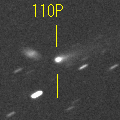
|
It brightened rapidly. Now it is 15.6 mag (Nov. 28, Toshihiko Ikemura, Hirohisa Sato). It is observable at 15 mag in excellent condition in winter.
Date(TT) R.A. (2000) Decl. Delta r Elong. m1 Best Time(A, h)
Dec. 11 8 41.22 17 20.9 1.721 2.478 130 15.2 3:23 ( 0, 72)
Dec. 18 8 39.76 16 46.6 1.664 2.484 138 15.1 2:54 ( 0, 72)
|

|
Now it is 15.8 mag (Oct. 4, Thomas Lehmann). Now it is not observable. It will appear in the morning sky at 15 mag in January. Then it will brighten up to 13 mag in 2022 summer.
Date(TT) R.A. (2000) Decl. Delta r Elong. m1 Best Time(A, h)
Dec. 11 16 9.01 -21 6.5 4.150 3.207 14 15.2 5:27 (292, -5)
Dec. 18 16 20.05 -21 43.6 4.110 3.197 19 15.2 5:31 (296, -1)
|

|
Now it is 16.1 mag (Nov. 22, Thomas Lehmann). It will brighten up to 12.5 mag in 2022 summer. In the Southern Hemisphere, it stays observable in excellent condition for a long time. In the Northern Hemisphere, it is not observable until August.
Date(TT) R.A. (2000) Decl. Delta r Elong. m1 Best Time(A, h)
Dec. 11 22 32.25 -69 36.8 4.324 4.011 65 15.2 18:19 ( 6,-15)
Dec. 18 22 25.51 -68 1.1 4.346 3.967 61 15.2 18:21 ( 10,-15)
|
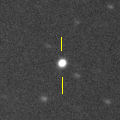
|
Now it is 14.1 mag (Nov. 28, Toshihiko Ikemura, Hirohisa Sato). It is expected to brighten up to 10 mag in 2023. In the Northern Hemisphere, it stays observable in good condition until 2023 autumn. In the Southern Hemipshere, it stays unobservable until 2023 summer.
Date(TT) R.A. (2000) Decl. Delta r Elong. m1 Best Time(A, h)
Dec. 11 13 2.37 37 49.8 5.674 5.663 84 15.3 5:27 (254, 62)
Dec. 18 13 4.38 38 52.2 5.521 5.607 89 15.2 5:31 (252, 68)
|
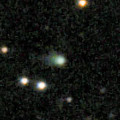
|
Now it is 15.9 mag (Nov. 17, A. Diepvens). It is expected to brighten up to 11 mag in 2023. In the Northern Hemisphere, it stays observable in good condition for a long time, although it became low temporarily in November. It is not observable in the Southern Hemisphere.
Date(TT) R.A. (2000) Decl. Delta r Elong. m1 Best Time(A, h)
Dec. 11 16 27.82 31 2.0 5.980 5.475 55 15.3 5:27 (246, 20)
Dec. 18 16 30.63 30 55.1 5.906 5.433 56 15.2 5:31 (249, 26)
|
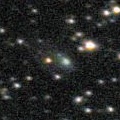
|
Now it is 14.9 mag (Nov. 28, Thomas Lehmann). It is expected to brighten up to 11 mag from spring to summer in 2022. In the Southen Hemisphere, it is not observable until February, but it stays observable in good condition for a long time after that. In the Northern Hemisphere, it is hardly observable after this.
Date(TT) R.A. (2000) Decl. Delta r Elong. m1 Best Time(A, h)
Dec. 11 18 59.31 -3 19.7 3.640 2.861 32 15.4 18:19 ( 75, 14)
Dec. 18 19 4.67 -4 41.7 3.638 2.799 27 15.3 18:21 ( 78, 9)
|

|
Now it is 15.9 mag (Oct. 8, Thomas Lehmann). It stays at 14-15 mag for a long time from 2021 to 2022. It is not observable from November to January.
Date(TT) R.A. (2000) Decl. Delta r Elong. m1 Best Time(A, h)
Dec. 11 16 51.37 -26 39.1 5.980 5.001 5 15.4 5:27 (292,-16)
Dec. 18 16 55.17 -27 27.6 5.966 5.005 11 15.4 5:31 (296,-11)
|
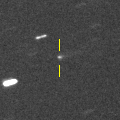
|
Now it is 15.4 mag (Dec. 3, Toshihiko Ikemura, Hirohisa Sato). It will brighten rapidly, and it will be observable at 13.5 mag in good condition from winter to spring.
Date(TT) R.A. (2000) Decl. Delta r Elong. m1 Best Time(A, h)
Dec. 11 10 2.16 16 40.5 2.109 2.641 112 15.7 4:44 ( 0, 72)
Dec. 18 10 5.65 16 31.3 2.004 2.617 118 15.5 4:20 ( 0, 71)
|

|
Now it is 15.2 mag (Nov. 29, Toshihiko Ikemura, Hirohisa Sato). It will be fading after this. In the Southern Hemisphere, it stays observable in good condition for a long time. It locates low in the Northern Hemisphere.
Date(TT) R.A. (2000) Decl. Delta r Elong. m1 Best Time(A, h)
Dec. 11 22 29.47 -18 37.3 5.016 4.830 73 15.6 18:19 ( 20, 34)
Dec. 18 22 32.32 -17 28.8 5.146 4.855 67 15.7 18:21 ( 28, 33)
|
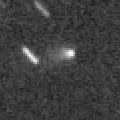
|
Now it is 17.6 mag (Dec. 11, Toshihiko Ikemura, Hirohisa Sato). It was expected to brighten up to 15.5 mag in winter. But actually, it is fainter than this ephemeris recently. In the Northern Hemisphere, it stays observable in good condition for a long time. It is not observable at all in the Southern Hemisphere.
Date(TT) R.A. (2000) Decl. Delta r Elong. m1 Best Time(A, h)
Dec. 11 16 12.52 65 3.9 2.852 2.997 88 15.7 5:27 (211, 35)
Dec. 18 16 18.55 66 31.8 2.796 2.985 91 15.7 5:31 (209, 38)
|
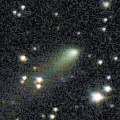
|
Now it is 15.1 mag (Nov. 10, Ken-ichi Kadota). It will be fading after this. In the Northern Hemisphere, it stays observable in good condition for a long time, although it became extremely low temporarily in November. In the Southern Hemisphere, it is not observable until late January.
Date(TT) R.A. (2000) Decl. Delta r Elong. m1 Best Time(A, h)
Dec. 11 16 12.29 17 36.8 3.067 2.442 43 15.7 5:27 (260, 17)
Dec. 18 16 13.11 18 10.8 3.034 2.469 46 15.8 5:31 (264, 23)
|

|
Now it is 15 mag (Oct. 31, Giuseppe Pappa). It will be fading slowly after this. In the Southern Hemisphere, it stays observable in good condition for a long time. In the Northern Hemisphere, it is not observable until July.
Date(TT) R.A. (2000) Decl. Delta r Elong. m1 Best Time(A, h)
Dec. 11 22 40.74 -60 29.3 4.202 3.913 66 15.7 18:19 ( 7, -6)
Dec. 18 22 50.68 -58 26.5 4.277 3.938 63 15.8 18:21 ( 10, -5)
|
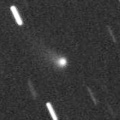
|
Now it is 15.5 mag (Dec. 4, Toshihiko Ikemura, Hirohisa Sato). In the Northern Hemisphere, it stays observable at 15-16 mag for a long time until early 2022. It is appearing in the morning sky also in the Southern Hemisphere.
Date(TT) R.A. (2000) Decl. Delta r Elong. m1 Best Time(A, h)
Dec. 11 13 19.74 16 29.3 3.423 3.205 69 15.8 5:27 (288, 51)
Dec. 18 13 19.48 15 41.1 3.338 3.229 75 15.8 5:31 (298, 56)
|

|
Now it is 15.4 mag (Nov. 21, ATLAS-MLO, Mauna Loa). It will be fading slowly after this. It will be unobservable in December.
Date(TT) R.A. (2000) Decl. Delta r Elong. m1 Best Time(A, h)
Dec. 11 20 33.30 -30 27.1 3.859 3.243 45 15.8 18:19 ( 40, 11)
Dec. 18 20 43.98 -29 48.4 3.939 3.259 40 15.9 18:21 ( 43, 9)
|
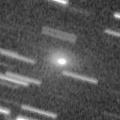
|
Now it is 15.7 mag (Nov. 28, Toshihiko Ikemura, Hirohisa Sato). It will be fading after this, and it will be fainter than 18 mag in February. It will be observable in excellent condition in the Northern Hemisphere. It locates somewhat low in the Southern Hemisphere.
Date(TT) R.A. (2000) Decl. Delta r Elong. m1 Best Time(A, h)
Dec. 11 7 22.11 37 21.4 0.975 1.887 148 15.8 2:05 (180, 88)
Dec. 18 7 16.99 38 33.0 0.982 1.918 154 16.0 1:32 (180, 87)
|
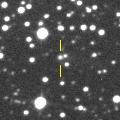
|
First return of a new periodic comet observed at 16 mag from 2003 to 2004. Now it is 16.0 mag (Nov. 27, Toshihiko Ikemura, Hirohisa Sato). It stays 16 mag until March, and it stays observable in excellent condition.
Date(TT) R.A. (2000) Decl. Delta r Elong. m1 Best Time(A, h)
Dec. 11 6 30.26 1 34.6 3.046 3.938 151 15.9 1:13 ( 0, 57)
Dec. 18 6 26.29 2 3.4 3.018 3.938 156 15.8 0:41 ( 0, 57)
|
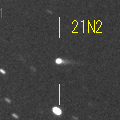
|
Brightened rapidly. Now it is 15.7 mag (Nov. 27, Toshihiko Ikemura, Hirohisa Sato). It is observable at 15.5-16 mag in good condition until winter.
Date(TT) R.A. (2000) Decl. Delta r Elong. m1 Best Time(A, h)
Dec. 11 2 2.75 11 56.6 3.051 3.800 133 15.9 20:42 ( 0, 67)
Dec. 18 2 2.67 11 37.3 3.133 3.802 126 15.9 20:14 ( 0, 67)
|
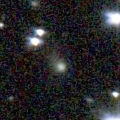
|
Now it is 16.0 mag (Nov. 5, Ken-ichi Kadota). It is expected to brighten up to 11 mag in 2023. In the Northern Hemisphere, it is observable only until November in 2022. In the Southern Hemisphere, it is not observable until February. But it will be observable in good condition at the high light.
Date(TT) R.A. (2000) Decl. Delta r Elong. m1 Best Time(A, h)
Dec. 11 18 2.15 20 23.0 6.268 5.617 45 16.0 18:19 (104, 16)
Dec. 18 18 6.93 19 44.5 6.240 5.568 43 15.9 18:21 (107, 11)
|
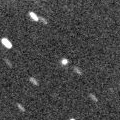
|
Now it is 16.9 mag (Dec. 1, Toshihiko Ikemura, Hirohisa Sato). It is expected to brighten up to 4.5 mag in 2022 April. However, it is not observable at the high light. In the Northern Hemisphere, it stays observable until early February when it brightens up to 14 mag. Then it will appear at 6 mag in mid May, and it stays observable in good condition after that while the comet will be fading. In the Southern Hemisphere, it stays observable until December when it brightens up to 16 mag. But after that, it is not observable until 2022 August.
Date(TT) R.A. (2000) Decl. Delta r Elong. m1 Best Time(A, h)
Dec. 11 22 0.18 6 3.6 2.635 2.583 76 16.2 18:19 ( 44, 53)
Dec. 18 22 4.07 4 57.7 2.645 2.482 69 16.1 18:21 ( 51, 48)
|
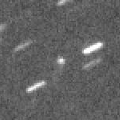
|
Now it is 16.8 mag (Nov. 28, Toshihiko Ikemura, Hirohisa Sato). It will brighten up to 16 mag in 2022. In the Northern Hemisphere, it stays observable in good condition for a long time. In the Southern Hemisphere, it is not observable until 2023.
Date(TT) R.A. (2000) Decl. Delta r Elong. m1 Best Time(A, h)
Dec. 11 10 25.75 79 19.2 3.435 3.949 114 16.1 5:08 (180, 46)
Dec. 18 10 39.46 82 11.5 3.408 3.930 115 16.1 4:54 (180, 43)
|
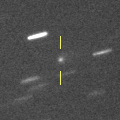
|
Now it is 16.7 mag (Dec. 11, Toshihiko Ikemura, Hirohisa Sato). It will brighten up to 15.5 mag, and will be observable in excellent condition in winter.
Date(TT) R.A. (2000) Decl. Delta r Elong. m1 Best Time(A, h)
Dec. 11 11 10.69 7 49.6 1.723 2.033 93 16.2 5:27 (347, 62)
Dec. 18 11 20.40 7 19.8 1.658 2.042 97 16.1 5:31 (358, 62)
|
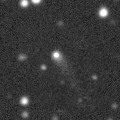
|
It stays observable at 16 mag from 2021 to 2022. Appearing in the morning sky in the Northern Hemisphere. In the Southern Hemisphere, it will appear in the morning sky in January.
Date(TT) R.A. (2000) Decl. Delta r Elong. m1 Best Time(A, h)
Dec. 11 15 25.36 7 31.1 5.448 4.736 40 16.3 5:27 (275, 21)
Dec. 18 15 31.51 8 15.5 5.388 4.743 44 16.3 5:31 (279, 26)
|
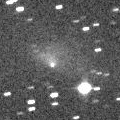
|
It brightened up to 10.1 mag in spring (Apr. 10, Marco Goiato). Now it is fading. It has already faded down to 16.3 mag (Dec. 10, Toshihiko Ikemura, Hirohisa Sato). It stays observable in good condition for a long time after this while the comet will fading.
Date(TT) R.A. (2000) Decl. Delta r Elong. m1 Best Time(A, h)
Dec. 11 3 59.78 5 47.9 1.802 2.729 155 16.3 22:38 ( 0, 61)
Dec. 18 3 54.09 6 11.1 1.881 2.770 148 16.5 22:05 ( 0, 61)
|
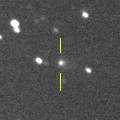
|
Now it is 15.8 mag (Nov. 27, Toshihiko Ikemura, Hirohisa Sato). It continues brightening even after the perihelion passage. It stays observable at 16-17 mag in good condition for a while.
Date(TT) R.A. (2000) Decl. Delta r Elong. m1 Best Time(A, h)
Dec. 11 4 40.97 -15 52.8 3.047 3.858 140 16.6 23:19 ( 0, 39)
Dec. 18 4 36.34 -15 19.9 3.088 3.876 138 16.6 22:47 ( 0, 40)
|
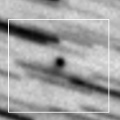
|
Now it is 17.1 mag (Nov. 27, Toshihiko Ikemura, Hirohisa Sato). It is expected to brighten up to 11 mag in 2022 summer. In the Northern Hemisphere, it stays observable in good condition until June when it brightens up to 11 mag. But it is not observable after the high light. In the Souther Hemisphere, it is not observable until 2022 October.
Date(TT) R.A. (2000) Decl. Delta r Elong. m1 Best Time(A, h)
Dec. 11 22 30.63 55 24.1 3.023 3.386 103 16.7 18:19 (155, 66)
Dec. 18 22 31.67 54 19.7 3.007 3.310 99 16.6 18:21 (146, 64)
|
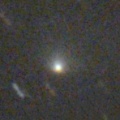
|
It brightened up to 14.5 mag in autumn (Oct. 1, Ken-ichi Kadota). Now it is fading. It has already faded down to 16.3 mag (Nov. 27, Toshihiko Ikemura, Hirohisa Sato). It will be fading rapidly after this. It will be fainter than 18 mag in February.
Date(TT) R.A. (2000) Decl. Delta r Elong. m1 Best Time(A, h)
Dec. 11 23 40.84 -13 17.3 2.139 2.377 91 16.7 18:21 ( 0, 42)
Dec. 18 23 49.35 -12 16.0 2.235 2.390 86 16.8 18:21 ( 6, 43)
|

|
Now it is 16.4 mag (Nov. 14, F. Kugel, M. Audejean, J. Nicolas, J.-G. Bosch). It brightened rapidly. It stays 17 mag for a long time from 2021 to 2022. In the Southern Hemisphere, it stays observable in good condition for a long time. In the Northern Hemisphere, it will be observable only in extremely low sky from autumn to winter.
Date(TT) R.A. (2000) Decl. Delta r Elong. m1 Best Time(A, h)
Dec. 11 8 51.21 -39 53.9 5.093 5.336 98 16.7 3:33 ( 0, 15)
Dec. 18 8 44.77 -41 23.7 5.035 5.338 102 16.7 2:59 ( 0, 14)
|
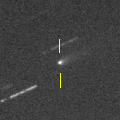
|
Now it is 16.7 mag (Dec. 3, Toshihiko Ikemura, Hirohisa Sato). It stays observable at 17 mag from autumn to winter.
Date(TT) R.A. (2000) Decl. Delta r Elong. m1 Best Time(A, h)
Dec. 11 12 3.88 1 2.2 1.817 1.885 78 16.7 5:27 (328, 51)
Dec. 18 12 14.37 -0 42.1 1.769 1.907 82 16.7 5:31 (337, 52)
|
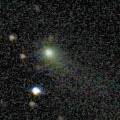
|
Now it is 17.3 mag (Nov. 27, Toshihiko Ikemura, Hirohisa Sato). It stays observable in good condition for a long time. But it will be fading after this.
Date(TT) R.A. (2000) Decl. Delta r Elong. m1 Best Time(A, h)
Dec. 11 23 27.77 6 12.6 1.980 2.304 96 16.7 18:19 ( 6, 61)
Dec. 18 23 36.21 7 4.8 2.079 2.321 91 16.9 18:21 ( 17, 61)
|

|
First return of a new periodic comet which brightened up to 17 mag in 2011. Now it is 17.6 mag (Dec. 3, Toshihiko Ikemura, Hirohisa Sato). It stays observable at 17 mag in good condition until spring.
Date(TT) R.A. (2000) Decl. Delta r Elong. m1 Best Time(A, h)
Dec. 11 12 46.02 -0 21.4 1.626 1.557 68 17.0 5:27 (315, 45)
Dec. 18 13 3.80 -2 10.0 1.585 1.562 70 16.9 5:31 (321, 45)
|
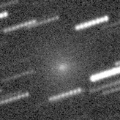
|
Now it is 15.6 mag (Nov. 17, Thomas Lehmann). It stays observable in good condition for a long time. It will be fading rapidly after this, and it will be fainter than 18 mag in January.
Date(TT) R.A. (2000) Decl. Delta r Elong. m1 Best Time(A, h)
Dec. 11 11 4.66 -7 37.9 1.426 1.713 88 16.9 5:27 (353, 47)
Dec. 18 11 10.71 -9 6.5 1.404 1.764 93 17.2 5:24 ( 0, 46)
|
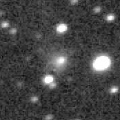
|
Now it is 16.7 mag (Dec. 1, Toshihiko Ikemura, Hirohisa Sato). Fading slowly. It is not observable until April in the Southern Hemisphere.
Date(TT) R.A. (2000) Decl. Delta r Elong. m1 Best Time(A, h)
Dec. 11 21 33.95 21 2.4 6.407 6.270 77 17.0 18:19 ( 71, 59)
Dec. 18 21 35.83 20 5.9 6.527 6.285 71 17.0 18:21 ( 76, 53)
|
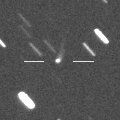
|
It was expected to brighten up to 14.5 mag from spring to summer. But actually, it is fainter than expected. Now it is 16.4 mag (Oct. 4, ATLAS-MLO, Mauna Loa). In the Southern Hemisphere, it stays observable for a long time. In the Northern Hemisphere, it is not observable after this.
Date(TT) R.A. (2000) Decl. Delta r Elong. m1 Best Time(A, h)
Dec. 11 12 0.72 -53 37.7 3.875 3.564 64 17.0 5:27 (349, 0)
Dec. 18 11 58.72 -54 1.3 3.845 3.610 68 17.1 5:31 (354, 0)
|
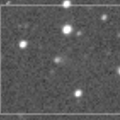
|
First return of a new periodic comet which brightened up to 17 mag in 2006. Now it is 17.2 mag (Nov. 23, ATLAS-HKO, Haleakala). It stays 17 mag from 2021 to 2022. In the Southern Hemisphere, it stays observable in good condition for a while. It locates extremely low in the Northern Hemisphere.
Date(TT) R.A. (2000) Decl. Delta r Elong. m1 Best Time(A, h)
Dec. 11 22 24.73 -43 49.3 3.380 3.114 66 17.0 18:19 ( 13, 10)
Dec. 18 22 33.62 -41 44.2 3.446 3.111 62 17.1 18:21 ( 18, 10)
|

|
Now it is 16.5 mag (Nov. 29, Toshihiko Ikemura, Hirohisa Sato). Fading slowly. In the Northern Hemisphere, it stays observable in good condition for a long time. In the Southern Hemisphere, it is not observable after this.
Date(TT) R.A. (2000) Decl. Delta r Elong. m1 Best Time(A, h)
Dec. 11 18 37.85 47 4.2 9.209 8.965 72 17.1 18:19 (127, 34)
Dec. 18 18 41.37 47 12.9 9.231 8.973 71 17.1 18:21 (129, 30)
|
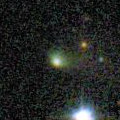
|
Now it is 16.9 mag (Nov. 27, Toshihiko Ikemura, Hirohisa Sato). It continued brightening even after the perihelion passage. But it will be fading after this, and it will be fainter than 18 mag in January.
Date(TT) R.A. (2000) Decl. Delta r Elong. m1 Best Time(A, h)
Dec. 11 0 58.78 -12 28.2 2.799 3.252 108 17.1 19:38 ( 0, 43)
Dec. 18 1 1.93 -11 42.2 2.928 3.292 103 17.3 19:14 ( 0, 43)
|
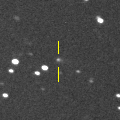
|
Now it is 16.7 mag (Nov. 27, Toshihiko Ikemura, Hirohisa Sato). It will brighten up to 14 mag in early 2023. It stays observable in good condition for a long time until spring.
Date(TT) R.A. (2000) Decl. Delta r Elong. m1 Best Time(A, h)
Dec. 11 4 33.85 2 30.9 4.168 5.092 157 17.2 23:12 ( 0, 58)
Dec. 18 4 30.41 2 40.9 4.152 5.048 152 17.1 22:41 ( 0, 58)
|
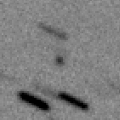
|
Now it is 17.5 mag (Nov. 27, Toshihiko Ikemura, Hirohisa Sato). It is observable at 17 mag from November to March. It is observable in good condition in the Northern Hemisphere, but it locates low in the Southern Hemisphere.
Date(TT) R.A. (2000) Decl. Delta r Elong. m1 Best Time(A, h)
Dec. 11 5 51.57 24 54.4 1.621 2.597 170 17.2 0:34 ( 0, 80)
Dec. 18 5 45.63 25 44.5 1.598 2.581 177 17.1 0:01 ( 0, 81)
|
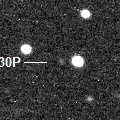
|
Now it is 18.5 mag (Nov. 28, Toshihiko Ikemura, Hirohisa Sato). It is expected to brighten up to 16.5-17 mag in winter. In its last apparition in 2015, it brightened up to 13 mag. But actually, it is fainter than this ephemeris recently.
Date(TT) R.A. (2000) Decl. Delta r Elong. m1 Best Time(A, h)
Dec. 11 22 43.81 -24 29.2 1.840 1.844 74 17.2 18:19 ( 14, 29)
Dec. 18 22 56.36 -22 50.0 1.871 1.811 71 17.1 18:21 ( 19, 30)
|
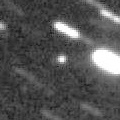
|
Now it is 16.3 mag (Dec. 2, Toshihiko Ikemura, Hirohisa Sato). In the Northern Hemisphere, it stays observable in good condition after this while the comet will be fading. In the Southern Hemisphere, it stays locating extremely low for a long time.
Date(TT) R.A. (2000) Decl. Delta r Elong. m1 Best Time(A, h)
Dec. 11 4 35.36 42 25.5 2.369 3.307 159 17.1 23:14 (180, 83)
Dec. 18 4 28.32 41 56.3 2.440 3.362 155 17.3 22:39 (180, 83)
|

|
Now it is 17.2 mag (Nov. 28, Toshihiko Ikemura, Hirohisa Sato). It stays 17-18 mag for a long time from 2021 to 2022. It is observable in excellent condition in the Northern Hemisphere, It locates somewhat low in the Southern Hemisphere.
Date(TT) R.A. (2000) Decl. Delta r Elong. m1 Best Time(A, h)
Dec. 11 3 43.23 33 5.4 4.499 5.425 158 17.2 22:21 ( 0, 88)
Dec. 18 3 32.41 32 30.2 4.542 5.417 149 17.2 21:43 ( 0, 88)
|
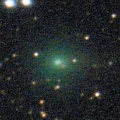
|
It brightened very rapidly up to 10.7 mag in July (July 20, Osamu Miyazaki). Now it is fading. It has already faded down to 17.6 mag (Dec. 2, Toshihiko Ikemura, Hirohisa Sato). It stays observable in the morning sky for a long time.
Date(TT) R.A. (2000) Decl. Delta r Elong. m1 Best Time(A, h)
Dec. 11 8 57.91 28 11.8 1.378 2.140 129 17.2 3:40 ( 0, 83)
Dec. 18 8 51.39 28 55.7 1.375 2.203 137 17.3 3:06 ( 0, 84)
|

|
It brightened up to 11.6 mag in winter (Feb. 18, Thomas Lehmann). Now it is fading. It has already faded down to 16.6 mag (Nov. 23, Thomas Lehmann). In the Southern Hemisphere, it stays observable in good condition after this. In the Northern Hemisphere, it will never be observable after this.
Date(TT) R.A. (2000) Decl. Delta r Elong. m1 Best Time(A, h)
Dec. 11 1 15.39 -61 42.3 4.619 4.606 83 17.3 19:54 ( 0, -6)
Dec. 18 1 10.33 -59 53.7 4.736 4.669 80 17.4 19:21 ( 0, -5)
|

|
Now it is 18.7 mag (Oct. 14, Catalina Sky Survey). In the Northern Hemisphere, it stays observable at 17 mag in good condition from November to December. It locates low in the Southern Hemisphere.
Date(TT) R.A. (2000) Decl. Delta r Elong. m1 Best Time(A, h)
Dec. 11 2 20.74 32 11.0 1.275 2.134 141 17.4 20:59 ( 0, 87)
Dec. 18 2 7.64 29 53.7 1.306 2.096 131 17.5 20:18 ( 0, 85)
|
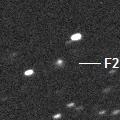
|
Now it is 17.8 mag (Aug. 4, ATLAS-HKO, Haleakala). It stays observable at 17-18 mag for a long time until 2024.
Date(TT) R.A. (2000) Decl. Delta r Elong. m1 Best Time(A, h)
Dec. 11 14 36.80 -5 49.8 9.626 8.907 41 17.4 5:27 (295, 22)
Dec. 18 14 37.76 -5 44.3 9.532 8.901 47 17.4 5:31 (300, 28)
|

|
Now it is 17.3 mag (Dec. 4, Toshihiko Ikemura, Hirohisa Sato). In the Northern Hemisphere, it stays observable for a long time while it is getting fainter slowly. In the Southern Hemisphere, it will never be observable again.
Date(TT) R.A. (2000) Decl. Delta r Elong. m1 Best Time(A, h)
Dec. 11 14 42.52 40 46.8 7.551 7.316 72 17.4 5:27 (244, 44)
Dec. 18 14 45.49 40 53.6 7.535 7.364 76 17.4 5:31 (246, 49)
|
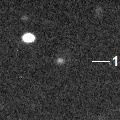
|
Now it is 16.9 mag (Dec. 1, Toshihiko Ikemura, Hirohisa Sato). It will brighten up to 15 mag in 2022 winter. It will be unobservable in February.
Date(TT) R.A. (2000) Decl. Delta r Elong. m1 Best Time(A, h)
Dec. 11 22 46.48 -15 20.4 2.868 2.840 78 17.4 18:19 ( 16, 38)
Dec. 18 22 53.35 -14 28.3 2.937 2.816 73 17.4 18:21 ( 23, 38)
|
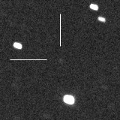
|
Now it is 17.8 mag (Nov. 25, ATLAS-HKO, Haleakala). It will brighten up to 11.5 mag in 2022 winter. It stays observable while the comet will be brightening slowly.
Date(TT) R.A. (2000) Decl. Delta r Elong. m1 Best Time(A, h)
Dec. 11 3 11.06 13 19.4 2.485 3.373 149 17.5 21:50 ( 0, 68)
Dec. 18 3 6.29 13 6.2 2.510 3.338 141 17.5 21:17 ( 0, 68)
|
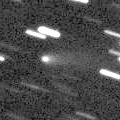
|
It brightened up to 15.2 mag in summer (Aug. 25, Ken-ichi Kadota). Now it is fading. It has already faded down to 17.5 mag (Nov. 28, Toshihiko Ikemura, Hirohisa Sato). It will be fainter than 18 mag in December. In the Northern Hemisphere, it stays observable in good condition for a long time. It locates extremely low in the Southern Hemisphere.
Date(TT) R.A. (2000) Decl. Delta r Elong. m1 Best Time(A, h)
Dec. 11 9 23.25 44 3.8 1.189 1.930 124 17.5 4:05 (180, 81)
Dec. 18 9 23.76 45 47.8 1.186 1.971 130 17.7 3:38 (180, 79)
|
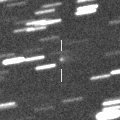
|
Now it is 17.1 mag (Nov. 28, Toshihiko Ikemura, Hirohisa Sato). It will be fainter than 18 mag in January.
Date(TT) R.A. (2000) Decl. Delta r Elong. m1 Best Time(A, h)
Dec. 11 9 19.46 21 48.5 1.628 2.317 123 17.5 4:01 ( 0, 77)
Dec. 18 9 17.21 20 59.2 1.592 2.353 130 17.6 3:32 ( 0, 76)
|
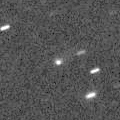
|
Now it is 17.2 mag (Dec. 10, Toshihiko Ikemura, Hirohisa Sato). It will be observable at 17 mag in good condition in spring.
Date(TT) R.A. (2000) Decl. Delta r Elong. m1 Best Time(A, h)
Dec. 11 13 16.63 -6 45.8 5.166 4.729 58 17.8 5:27 (312, 35)
Dec. 18 13 21.54 -7 17.0 5.067 4.726 64 17.7 5:31 (319, 38)
|
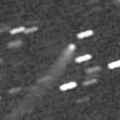
|
Now it is 17.5 mag (Nov. 13, D. Buczynski). Fading slowly. In the Northern Hemisphere, it stays observable in good condition for a long time. It is not observable after this in the Southern Hemisphere.
Date(TT) R.A. (2000) Decl. Delta r Elong. m1 Best Time(A, h)
Dec. 11 16 44.52 48 22.3 6.423 6.183 71 17.8 5:27 (227, 26)
Dec. 18 16 48.37 48 50.8 6.432 6.219 73 17.8 5:31 (229, 30)
|
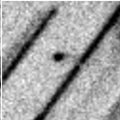
|
Now it is 17.6 mag (Nov. 27, Toshihiko Ikemura, Hirohisa Sato). It is observable at 17-18 mag in good condition from November to December.
Date(TT) R.A. (2000) Decl. Delta r Elong. m1 Best Time(A, h)
Dec. 11 4 33.70 16 29.6 0.961 1.937 168 17.8 23:10 ( 0, 72)
Dec. 18 4 10.21 21 33.3 1.003 1.953 158 17.9 22:20 ( 0, 77)
|
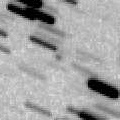
|
Now it is 18.5 mag (Nov. 27, Catalina Sky Survey). It is expected to brighten up to 13.5 mag from June to July. It is observable only in the Southern Hemisphere at the high light. In the Northern Hemisphere, it is observable only until March when it brightens up to 16.5 mag.
Date(TT) R.A. (2000) Decl. Delta r Elong. m1 Best Time(A, h)
Dec. 11 1 45.03 27 2.3 2.009 2.779 133 18.0 20:23 ( 0, 82)
Dec. 18 1 33.91 23 31.1 2.031 2.701 123 17.9 19:45 ( 0, 78)
|
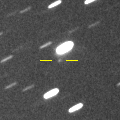
|
Now it is 17.9 mag (Nov. 27, ATLAS-HKO, Haleakala). It is observable at 17 mag in good condition from winter to spring.
Date(TT) R.A. (2000) Decl. Delta r Elong. m1 Best Time(A, h)
Dec. 11 9 54.25 -26 42.0 2.120 2.422 95 18.0 4:36 ( 0, 28)
Dec. 18 10 1.02 -27 26.8 2.039 2.407 99 17.9 4:15 ( 0, 27)
|
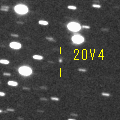
|
Now it is 17.7 mag (Dec. 2, Toshihiko Ikemura, Hirohisa Sato). It is observable at 18 mag in good condition in winter.
Date(TT) R.A. (2000) Decl. Delta r Elong. m1 Best Time(A, h)
Dec. 11 8 6.55 3 16.2 4.476 5.202 133 17.9 2:49 ( 0, 58)
Dec. 18 8 4.75 3 6.7 4.413 5.207 140 17.9 2:19 ( 0, 58)
|
|
![]()
 P/2021 Q5 ( ATLAS )
P/2021 Q5 ( ATLAS ) C/2019 T3 ( ATLAS )
C/2019 T3 ( ATLAS ) C/2019 T2 ( Lemmon )
C/2019 T2 ( Lemmon ) 422P/2021 L1 ( Christensen )
422P/2021 L1 ( Christensen ) C/2019 O3 ( Palomar )
C/2019 O3 ( Palomar ) C/2021 K1 ( ATLAS )
C/2021 K1 ( ATLAS ) C/2020 S4 ( PanSTARRS )
C/2020 S4 ( PanSTARRS ) 274P/Tombaugh-Tenagra
274P/Tombaugh-Tenagra 230P/LINEAR
230P/LINEAR 28P/Neujmin 1
28P/Neujmin 1 C/2020 U4 ( PanSTARRS )
C/2020 U4 ( PanSTARRS ) 15P/Finlay
15P/Finlay C/2019 N1 ( ATLAS )
C/2019 N1 ( ATLAS ) (3200) Phaethon
(3200) Phaethon C/2020 F2 ( ATLAS )
C/2020 F2 ( ATLAS ) C/2018 N2 ( ASASSN )
C/2018 N2 ( ASASSN ) 119P/Parker-Hartley
119P/Parker-Hartley 81P/Wild 2
81P/Wild 2 106P/Schuster
106P/Schuster 241P/LINEAR
241P/LINEAR 99P/Kowal 1
99P/Kowal 1 C/2019 K7 ( Smith )
C/2019 K7 ( Smith ) P/2021 U3 ( Attard-Maury )
P/2021 U3 ( Attard-Maury ) C/2021 T2 ( Fuls )
C/2021 T2 ( Fuls ) C/2021 U5 ( Catalina )
C/2021 U5 ( Catalina ) P/2020 V4 ( Rankin )
P/2020 V4 ( Rankin )![]()








































































